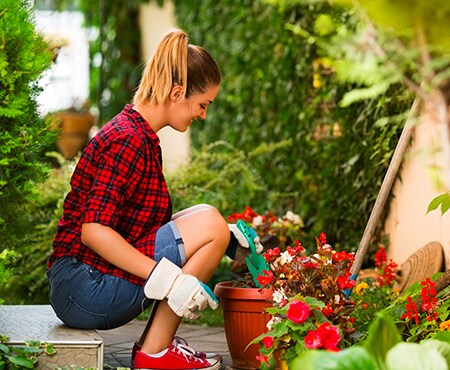Special Awareness Days
June 6th - National Gardening Exercise Day

Ready to Order?
If you are ready to order, please contact Customer Service:
Telephone: 1 (800) 361-6128 Fax: 1 (800) 563-9196
Introduction
Those of us who plant gardens—anything from a small patio planter of herbs to a large flower or vegetable patch—know that the body gets a good workout! Not only are gardens a wonderful way to experience nature and reap the benefits of a good crop, they are also an excellent way to keep fit.
No one is sure where “National Gardening Exercise Day” originated but clearly it is reason for celebration! Whatever you plant, there is simple joy in watching it grow. At the same time, the planting, maintaining, and harvesting provides great exercise for the mind and the body. Gardening with kids is a great way to promote sustainability and environmental awareness, as well as healthy eating, mindfulness, and active living.
Besides the therapeutic elements of fresh air and sunshine as we garden, we engage in weeding, digging, spading, planting, pruning, mowing, raking, and walking! And…let’s not forget to exercise the brain too! A garden can provide great ways to get in touch with our senses and feelings. It is a wonderful place to cool down and seek relief from tension. Remember, kids feel stress too!
Activity Bursts
Grades K-2
Physical Activity, Nature Appreciation
Note:
The following activity can be enhanced by planning a field trip to a local garden centre. Arrange for a worker to take students on a tour and then ask him or her to explain the physical work that goes into maintaining the garden centre. Ask the proprietors if they might have any flowers that could be donated to your school.
If a field trip is not possible, try to obtain at least one flower (with earth, roots etc.) for each student to plant.

Note: Check with your local gardening centres to see if they have created a virtual tour of their facility. You could also ask local gardeners to join you in class or virtually to talk about the fun and exercise involved in gardening!
In the classroom before your visit:
Ask students to bring paper and paint, markers or crayons to the lesson. Invite them to create a picture of flowers- lots of flowers!
Share the pictures and ask:
- What words would you use to describe how you felt while making your flower picture?
- What colour did you use most often? Why?
- Do your flowers have a smell? Can you describe it?
- What do the petals on your flowers feel like?
- Did you put leaves on your flowers? What are they like?
Explain that flowers often make people smile. That is why we give flowers to people when they are sick or when they are celebrating something special or even when we just want to do something nice for someone.
Ask students if any of them have planted flowers at home. Share responses. Explain that gardening is also a good way to exercise our bodies. Ask students why they think this is true.
Ask students to show you how a flower grows with their bodies. Start from a crouch position and invite them to slowly grow and open up to be beautiful flowers!
Then, ask them to describe what has to be done to keep the flowers growing.
Explain that gardens don’t get beautiful by themselves. People have to take care of the plants by watering them, weeding them, thinning them, etc., and that means they have to use their bodies!
Have students stand and act out the following physical activities related to gardening as you describe the process:
- First we need to loosen the soil. Let’s squat and pretend we are getting those clumps of dirt all broken up.
- We need to dig a hole that is big enough for the flower—not too deep!
- Next, we need to carefully take the imaginary flower out of the container while making sure we don’t damage the roots.
- Let’s add some water to the hole. The hose is over on the side of the garden so let’s pull it over with our arms .
- Add a little water and then put your flower carefully into the hole.
- Gently replace the dirt around it to support the stem.
- Wow! Stand back and look at your imaginary flower. How does it make you feel?
- Don’t forget we will often have to use the hoe around our plant to keep the weeds away and water it often.
If you were able to obtain some flowers, take students outside to plant them.
Ask:
- What was your favourite part about our experience today?
- Do you think that planting a garden is hard work? Why?
- What other kinds of gardens could you plant?
Encourage students to get their family involved in planting a flower garden. Remind them that flower gardens can be big or small. They can be planted in the ground, in a garden box or pot, or even in a cup! Remind students that they will have to take care of their flowers so that they will grow and be beautiful for everyone to enjoy!
Grades 3-5
Physical Activity, Science, The Environment, Mental Health, Art, Language Arts
Ask:
- Have you ever planted a garden? What kind?
- Why do you think so many people like to make gardens?
- Do you think gardening has any physical benefits? Explain.
Discuss the elements of gardening that involve physical activity (e.g., squatting, bending, reaching, digging, stretching, etc.)
Ask students why gardening can be as good for your mind as it for your body. Share that besides the experience of fresh air and sunshine that makes everyone feel good, gardening can help to improve your mood and make you feel that you are accomplishing something important. It can also give you an appreciation for the environment and the importance of taking care of our earth.
Explain that spending time in a garden is a great way to relax and enjoy nature. It is also a time to exercise not only our bodies, but our brains as well.
Ask students to create a mind picture (visualization) of a garden that they would like to grow. They can close their eyes if that helps them to “see” their garden. Guide them through the experience by asking:
- listen: What do you hear? Are there bees or other insects? Can you hear any birds? Are people talking? Is there a wind chime? Are there cars going by?
- look: What colours do you see? Which ones do you like best? Why? Are there any butterflies? What colour are they?
- touch: Without causing any harm to the plants, what can you feel? What is on the ground? Dirt? Cement? Pebbles? How do they feel? Are they smooth? Rough? Cold? Warm? If there are leaves or flowers that have fallen to the ground, how do they feel? Are they bumpy? Soft?
- smell: Can you smell the flowers? Is there a smell in the earth? Any other smells in the air?
- feel emotions: What are you feeling right now? What words would describe how you feel in this garden? Do you find it relaxing? Are you enjoying this experience?
Debrief the experience by asking:
- How did you feel when you created your imaginary garden? Why do you think you felt that way?
- Do you think you would like to create your own garden? Discuss. What would you have to do to make sure your garden grows and stays healthy?
- Why do you think some people find gardening relaxing, even though it is hard work?
In closing, remind students that exercising their mind is just as important as exercising their body. Share that this kind of experience can be a good and healthy way of “cooling down” or relaxing their minds when things become stressful.
Grades 6-8
Physical Education, Community Involvement, Art, Nature, Environmental Stewardship
Note: Check with your local gardening centres to see if they have created a virtual tour of their facility. You could also ask local gardeners to join you to talk about the fun and exercise involved in gardening!
Share the information in the Introduction. Consider the following activities that students of this age might enjoy:
- Explain that gardens are wonderful places for many reasons. In addition to keeping our bodies fit through the exercise required in gardening, they are also a place where we can exercise (and relax) our minds. Invite students to use their senses when they describe what it would be like to grow a beautiful garden. Encourage them to think about other places where they can apply exercises for their bodies and their minds.(See the Activity burst for grades 3-5.)
- As part of appreciating the importance of nature, gardening, and environmental stewardship, invite students to research the amazing voyage of the Monarch butterfly. Encourage them to find videos and to check out the recent encouraging increase in the numbers of butterflies that have been seen in Mexico last spring!
Invite them to create a butterfly garden or butterfly feeder. You will find some great ideas at: https://www.diyncrafts.com/36001/home/gardening/10-diy-butterfly-feeders-will-add-beauty-butterflies-garden - Invite students to create a garden (flowers or vegetables) at or near their home. Remind them that gardens can be big or small. They can be planted in the ground, in a garden box or pot, or even in a cup! Ask them to describe what the experience would be like by answering the questions below:
- What parts of your body did you exercise during this experience?
- Do you think gardening is a good source of exercise? Why?
- What hints or preparations would you recommend to someone who has never planted a garden before, so they don’t injure themselves?
- Would you like to plant your own garden?






